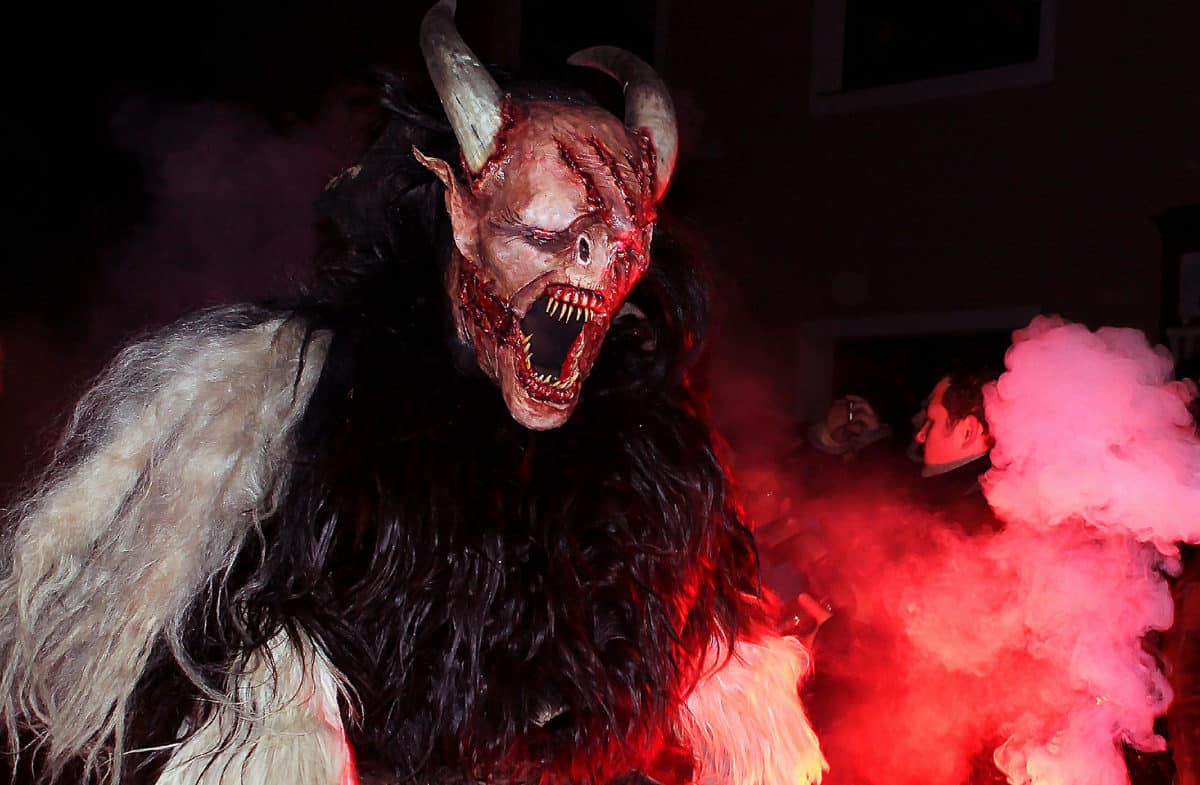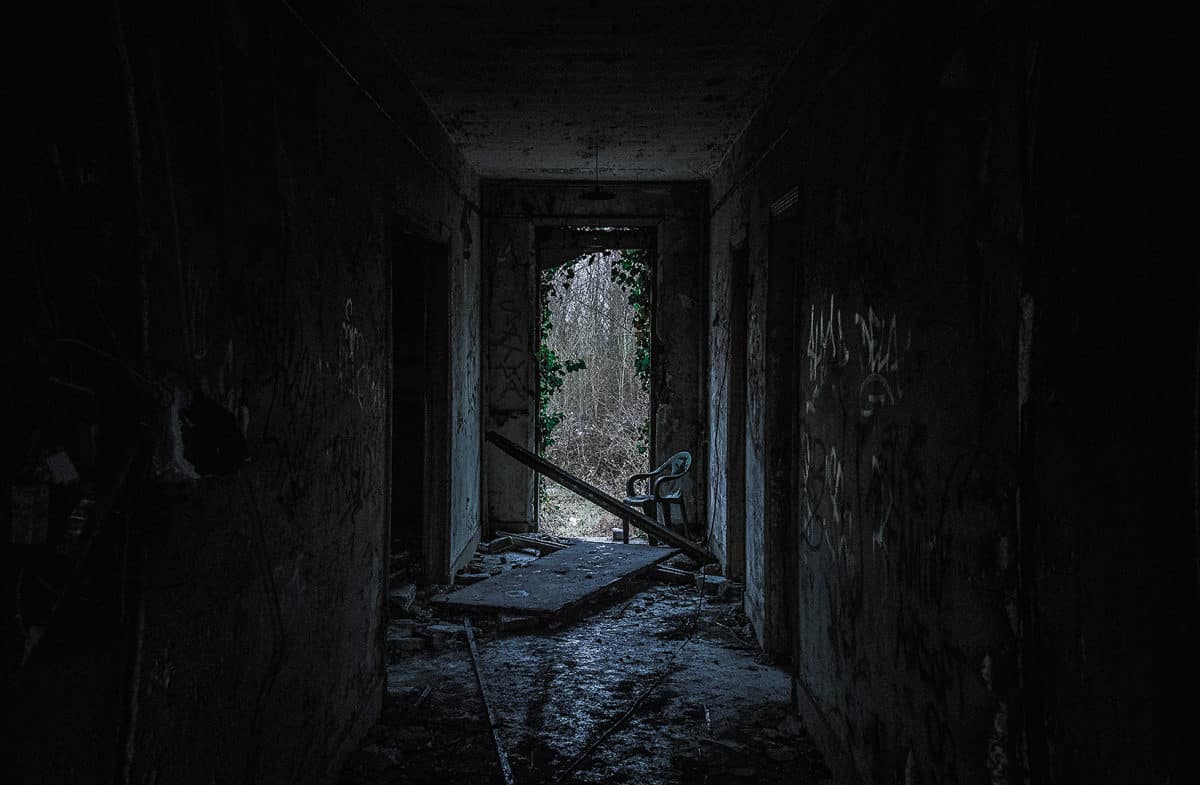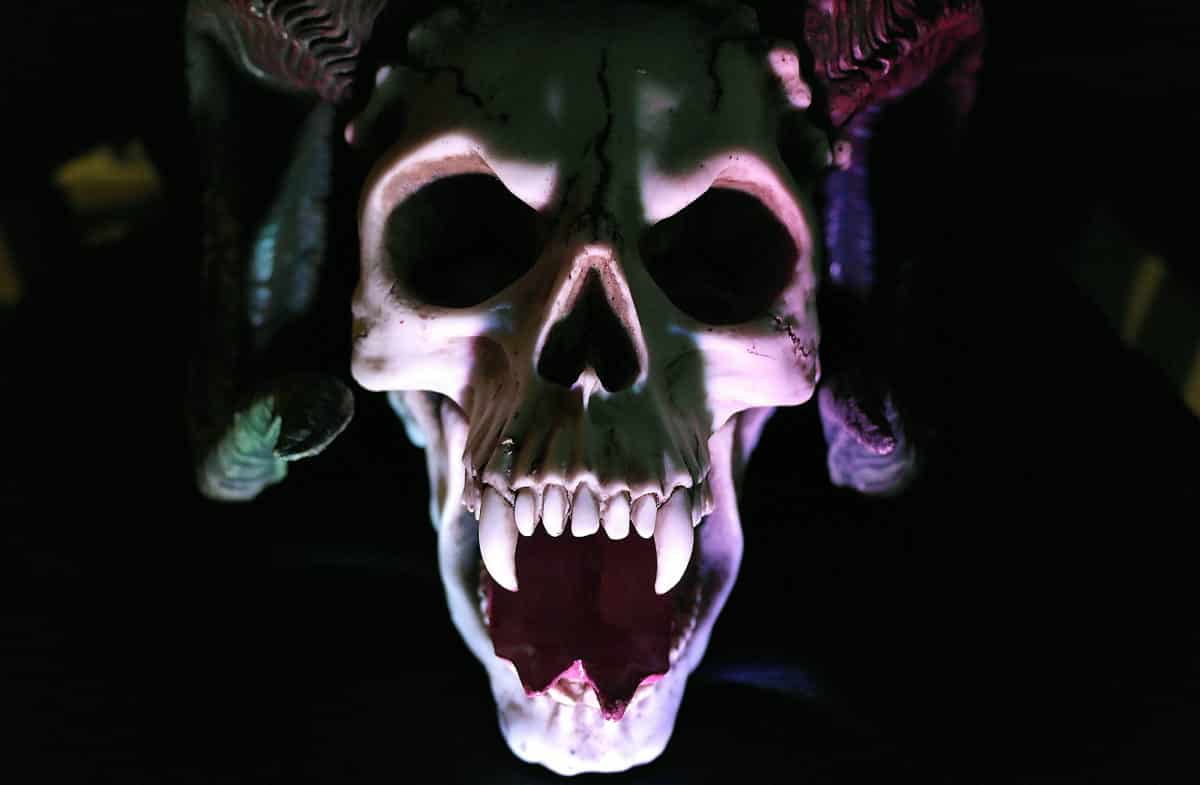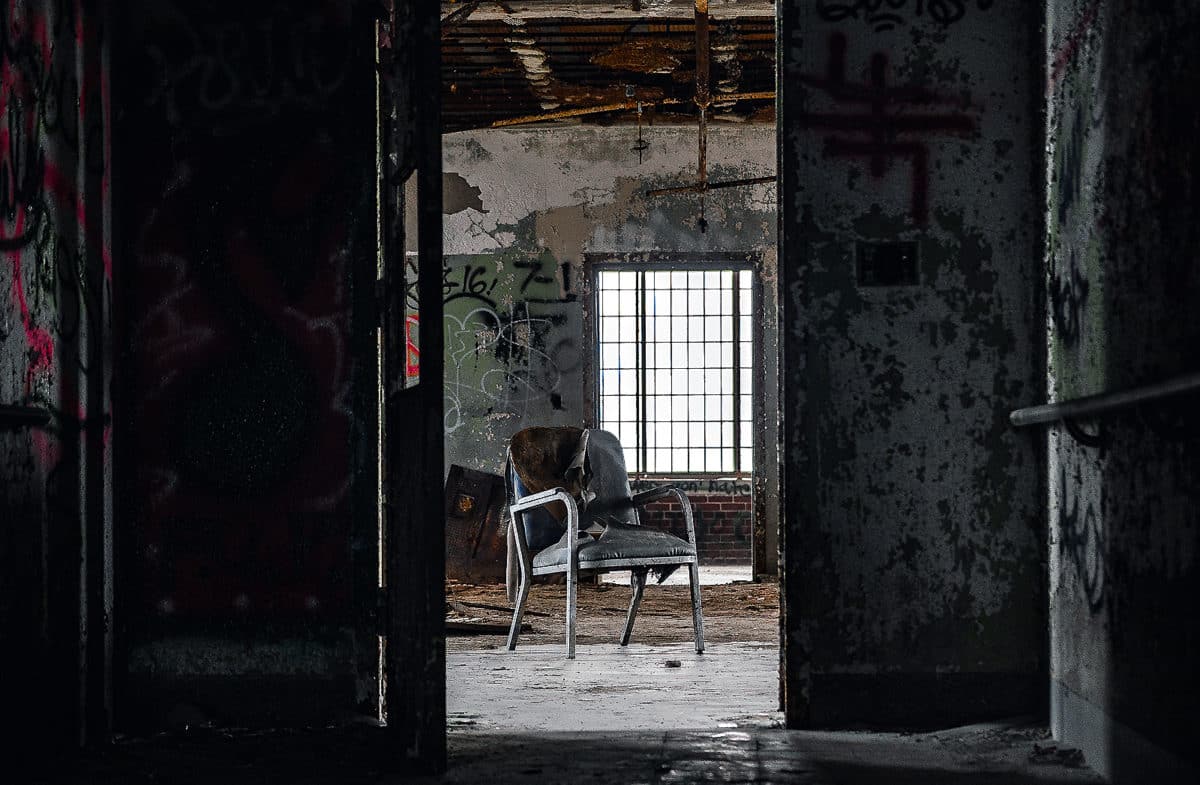Jonathan and Crystal Discuss Six Approaches for Creating a Memorable “Last Room” in Your Haunt.
This blog is based on our Haunt Weekly podcast, Episode 182, in which we discussed “The Last Room.” You may have heard that the last room is the most important room of the haunt. There are some reasons for that. It’s the easiest to remember and, if you’re standing in the queue line, there’s a good chance that’s the room from which you see guests emerging. Because of that, it may actually set the tone for the haunt in a bigger way than the first room. The last room can be both the first room and the last room that guests see. They see the aftermath as people come out of it before they even enter the haunt, and then they see the room for themselves at the very end.
In a nutshell, the goal of the last room is to put on a spectacle for the guests waiting in the queue line, and basically keep that throughput moving. You can’t have chokes at the end of the haunt.
The last room also has the very important job of tying together the haunt. If your last room is too off-the-wall, it can hurt more than it will help. You’ve got to find a balance there. There are reasons not to put too much pressure on yourself with that final room. Think about it: For those of us who’ve been to lots of haunts, how many final rooms can you really remember?
“Yeah, I’ve been trying to think of any, and I can’t,” said Crystal.
The Mortuary remains unchanged. Classic House of Shock still has a barrel wall, even though that wasn’t really the last room—it was more of an escape sequence. But other than haunts we went to year after year, I’m really struggling to remember a lot of last rooms. Going back to the Atlanta trip, I remember Freaks of Fear, the birds swooping down on us. That was a huge climax moment.
“Whenever I think of haunts and what I associate with each one,” said Crystal, “it’s usually not the first or the last room. It could be an opening sequence of a scene that I hadn’t seen done anywhere else, but, lots of times, it’s just what made that haunt unique.”
Here are some things to think about when considering the last room.

Approach Number 1: The Chainsaw Room
There’s a chainsaw room in more than half of the haunts we go to. In terms of laying out the scare and thinking about the tactics for it, it’s basically a guy with a chainsaw after the guests. That’s it, and it works. It doesn’t need much decorating or selling. The chainsaw hallway at the Mortuary is just a black hallway.
People do expect the chainsaw, but it doesn’t necessarily have to be at the end. The chainsaw room is cheap, fast, effective, and, once you’ve got a good chainsaw guy who can really wield it properly, you’re all set. I am not that guy—that’s why I have such respect for them. It can be a very powerful scare, especially for the majority of people. It seems to me it’s getting less and less effective as people have come to expect it. It’s more like the chant of “Encore” than it is a scare unto itself now.
The chainsaw room can be a perfect ending, except for the fact that almost everyone does it. The best use I ever saw of it was Evil Intentions, now based in the Chicago area, because they had their chainsaws at the midpoint. We came around a corner, and I heard the chainsaw. I thought, “OK, that was a little short, it was a good haunt, so I’m happy with the ending, I’m good with it ending here, that’s fine.” Then the chainsaw revs, we move forward, turn a corner, and boom, it’s only the halfway point of the haunt. They knew I’d been through 100 other haunts, or that I’d been to a few other haunts where the chainsaw was the ending. It wasn’t chasing me into the next section. It worked so beautifully and created such an impactful memory.
Now, here’s the other thing I’d like to say: The chainsaw room can be extremely unsafe. We warn people not to run in haunts. Rule one in every haunt is, “No running.” Then we pull out chainsaws and force guests to run. Some haunts simply aren’t built for the chainsaw room.
Case in point: Evil Visions in Monroe, Louisiana had a chainsaw at the end, but their exit was a fire exit on the side of the warehouse that led to a docking ramp. If you went out the door, you had about five feet of clearance, and then there was a rail. If you went over that rail, you were in traffic on a busy street in downtown Monroe.
“It was a very short ramp,” remembered Crystal, “and the guests did run out into the street.”
The group behind us nearly body-checked our ass over that rail when they came out, and they did run out into the street. Luckily, the stoplights were such that they didn’t have a problem. However, that exit was inappropriate. We talked in Episode 52 about a haunt visitor who was fleeing from a chainsaw at a haunt in a rural area of North Carolina. He ran into traffic, got hit by an SUV, and was severely injured. The haunt raised funds for his medical care. They donated half of the rest of their revenue that year to him. The chainsaw guy was the injured guy’s friend, and he was messing with him, but he also stopped chasing him way before he got to traffic. Chainsaw Man yelled at him to stop, took off his mask, did everything he could to stop the guy, and it didn’t happen. You can’t predict how, where, how far, or how fast the people are going to run, especially when they’re at the exit, especially when you’re pushing them into the outside world.
Crystal added, “You can’t really predict customers’ response at all in a scare.”
My final thought on chainsaws: It’s overdone, but people expect it and want it. We have a no-chainsaw rule in our haunt, and we’ve maintained it partly because we think it’s overdone and partly because we don’t have a place for it. If you feel you need to have it, consider it as a false ending, because that’s messing with the expectation customers have coming in. It’s messing with it in a positive way, because they think something is over and you’re giving them more.

Approach Number 2: The Maze.
This is another element we really don’t like.
“Yeah, and we actually covered how much we don’t like mazes in Episode 23,” added Crystal.
Here’s the thing about mazes—they’ve been out of fashion since sometime in the ‘90s. Everyone’s first haunt had a maze and, usually, some marketing that went like this: “This haunt can take anywhere between 18 minutes and three hours!” Mazes are cheap and easy, especially for charity and smaller haunts that don’t have much of a budget. They’re easy to build and provide lots of walkthrough. The problem, however, is that they ruin throughput.
“Not only does it ruin throughput,” Crystal pointed out, “but you often have to get special clearances from fire marshals for them, because the exits are intentionally hidden.”
We need to distinguish between a labyrinth and a maze. A labyrinth is a winding path. A labyrinth will take the windingest route possible to get there, but there’s only one path, so you never get lost as long as you keep moving forward and don’t get turned around. You’re always going toward the exit. A maze, on the other hand, has dead ends where you hit walls and have to turn around. A labyrinth is much easier to contend with in a fire or other emergency situation than a maze.
“We’ve seen mazes that hide the doors to look like walls, so you can’t actually find the exit,” Crystal added.
We went to the Waterloo Sportsman Club in Southeastern Illinois not knowing what to expect from their haunted attraction. We found an amazing haunted trail that ended with a maze—some hidden doors—which ruined my experience. Mazes are inherently unsafe. There are blind corners, and because of dead ends, there’s no single flow of traffic. Usually you want every customer moving along the same path. With a maze, they have to bypass each other going in opposite directions.
Mazes are a great way to end the haunt on a boring, frustrating note. If your goal is to disorient people, use your layout for that. People lose their orientation after just three turns. We always put three turns at the beginning of the haunt.

Approach Number 3: A Climactic Scene
The best example of a climactic that I can think of was at House of Shock, when it was running. For many years, they tended to end with a sacrifice sequence. They kept adding stuff after it as time went on.
“Yeah,” said Crystal, “because then you had to go through the walkway, past the dragon, and through the coffin.”
The dragon and sacrifice scene were part of the same room, the same sequence, because you really didn’t leave one area and go into another. In my book, it was part of the same little cave bit.
“You and I have different ideas of what a room is.”
That’s fine, that’s fine. I’m thinking “sequence” here more than actual room, because, early on, when we first started going 2002 or 2003, it was like—sacrifice sequence, dragon, and then, pretty much, you were outside. They added a chainsaw maze after that, and then they moved it inside, and then Katrina happened, and then they had to redo everything. They kept that sequence but would then add things after it that weren’t always as memorable or as good. There was a really good pop at the end, especially since it ended with characters from the stage show. That was the bookend. They began it with a stage show, and they ended it with a kind of a stage show, and that was the bookend. It was beautiful, it sent me out the door, and I was done. But then it was like, “Oh wait, there’s some more random crap still.”
“There’s a chainsaw maze to go through.”
While I did love the falling barrels gag, it’s like, why is that here?
“Yeah, because it didn’t match anything anywhere else in the haunt. It was a beautiful setup—everybody loved it.”
It would have been so much more impactful if it were in the industrial sequences in the middle. That’s just my opinion, and I could be wrong. This idea of doing a climactic scene makes sense to me, because then you can start with an opening room, do some interactivity, get some backstory in, and then crescendo the haunt up to this final sequence.
You know what? One haunt that did this really, really well—and which you can take a tour of at the upcoming Midwest Haunters—is Massacre Haunted House. They did the one where they were… it starts with the kid’s name…
“Willow.”
They started with whispering the name in small scenes, the scenes got more and more grand, and they crescendo to the final sequence. It worked very well and, once again, they had an escape thing afterwards, and I think that one actually did involve a chainsaw.
“The thing is, a lot of the places that do an escape thing—13th Gate comes to mind—have a cooldown hallway, because if you ran out of there, you’d run right out into traffic. So, in some places, you have to have the layout where there’s a cooldown at the end,” advised Crystal.
I like this approach from a storytelling standpoint. It just makes sense to me. It’s probably my favorite way to look at it, in general, but it might not be right for every haunt.
“That’s what we’re going to be working up to this year,” said Crystal. “We’re going to be ending on a pretty big scene for us to pull off, so if you’re coming to HAuNTcon, let us know, because we’ll be doing our little tour.”

Approach Number 4: Just Another Room
So, you can have the last room be just another room. As with the first room, make it a good room, make it a solid room, make it something that has a good scare in it, but just make it ordinary. This, to me, seems like a weaker option. Making your first room an ordinary room makes a lot of sense, because that’s setting the expectations. With the last room, this is your chance to play with those expectations. What expectations have you created with what you’ve done up to that point, and how can you muck with it in the last room and throw people off? That’s the real advantage, the real fun of the last room—or the last two rooms, maybe. You’ve spent all of your haunt getting people used to things, so now you can fuck with that, and you should. It’s a chance to play upon those expectations, so, yeah, it makes sense to do something different in the last room, but it doesn’t necessarily have to be a big, special climax. It can just be something a little different. That being said, if you do have a regular room at the end, it can feel a little incomplete, it can feel like, “Oh, it’s over?” It doesn’t provide that palate cleanser.
Crystal added, “Yeah, because we’re waiting for the big, climactic ending.”
For us, that happened with Terror on the Coast. It ended, and it was like, “Oh, that’s it. OK.” It didn’t feel like it was finished to me. I was assuming we were going into trail-haunt mode, but that didn’t happen, either. So, anyway, consider something that ties up the plot but maybe isn’t the climax. Something that still says, “This is the end,” can be fine, and it doesn’t necessarily have to be a giant climax. That could be cooler if you have the space and the ability, but the main thing is, have a room, make it good, make the scare solid, and tie together the story.

Approach Number 5: The False Ending
We’ve seen this one pulled off successfully many times—you let people think the haunt is over, give them a chance to let their guard down, and then, it’s, “Hit me, baby, one more time,” basically. This is popular at trail haunts. I’ve seen this at Freaks of Fear, which we mentioned earlier, and they did it very well, I might add. We’ve seen it at Psychopath. They’ll do a sequence that makes guests think it’s over and let them get some distance away. The guests will be thinking, “OK, we’re walking back to the car now.” But no, they’re not actually out of the haunt yet. I dig that kind of false ending, I really do, but you can’t overdo it, you can’t hotshot it. If you can pull it off, and have people genuinely let down their guard, it can be fun.
Now, do bear in mind, you have the same issues with this that you have with the chainsaw in that it can be dangerous. People are running when maybe they shouldn’t be and running in places you may not have the tightest control over. In general, the courts have been very lenient on us haunts when we chase people and they twist their ankle, cut themselves, or whatever. If the courts find out you’re knowingly chasing people in areas you know aren’t safe to run through, they may not be as kind. Be thinking of that.
But, here’s the thing: You don’t have to do the chainsaw here. You can do various pop-outs. There were no chainsaws at the end of Freaks of Fear.
“There was a clown guy,” said Crystal.
There was a clown guy who was very stalkery. I don’t know how the hell he was moving like that. He was hauling some boogey. You can do simple pop-outs, you can do traditional direction-startle scares, you have possibilities there that don’t necessarily involve a chainsaw or anything that might send people running too far too fast. You can do something a little more muted but still very memorable. Be wary, though, that this might make the afterpart more memorable than the haunt itself. You can be too successful here. There have been several haunts that had more memorable parking lots than the attraction itself, and I’d include the very first haunt we worked at. There was a guy with a ginormous, gas-powered chainsaw in the parking lot scaring people as they were walking to their cars. Yeah, everything else inside the haunt was fine, but I can guarantee you nothing got anywhere near the same reactions that he did.

Approach Number 6: Transition to Another Attraction
If you have two attractions on your property, the easiest way to end one may be to simply flow into the next. I’ve not actually seen this done, even though this is an idea I’ve had for a while.
I want say here that I have a personal belief that if I can’t buy tickets to your attraction separately, you don’t have two attractions. You have one attraction with two themes. There’s a difference.
“Sure is,” said Crystal.
Now, mind you, this approach can work with either. It’s a way to end one section by flowing into the next. Basically, you have the last room of Haunt A be pretty much the first room of Haunt B. It flows out into the queue line, and then you’re primed and ready for Haunt B. I can see that working really, really well. You can even make this infinite-loop situation where the last room of Haunt B flows back into Haunt A, so no matter which order guests do it in, the last room in one works as the first room in the next. The guests can pick and choose their own order. I kind of dig that idea of infinite loop, especially if you can buy tickets for the attractions individually. For example, you can buy tickets to the Asylum and to Rise separately. We typically choose to do the Asylum first, because, A, we’re always excited about it, and, B, the line is shorter.
“Well, and that’s the other thing,” said Crystal. “It depends on the line, because if the line at the house is short, we just jump into that one.”
In summary, all six of these approaches to the last room encourage interactivity without impacting throughput. That’s tough, especially when so few haunt actors are good at doing interactivity anyway. It’s such a rare thing to find that. So, basically, find the way to subvert expectations while giving your customers exactly what they thought they were going to get. I know that sound completely counter-intuitive, but it’s possible. Like I said, you’re responsible for setting up those expectations, so you should have the easiest time in the world knocking them down.